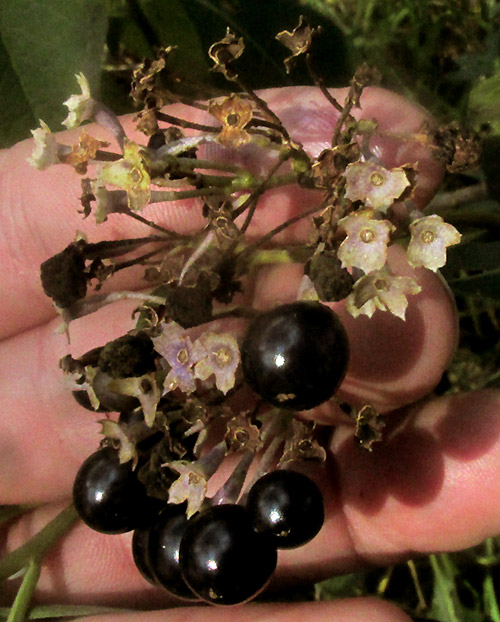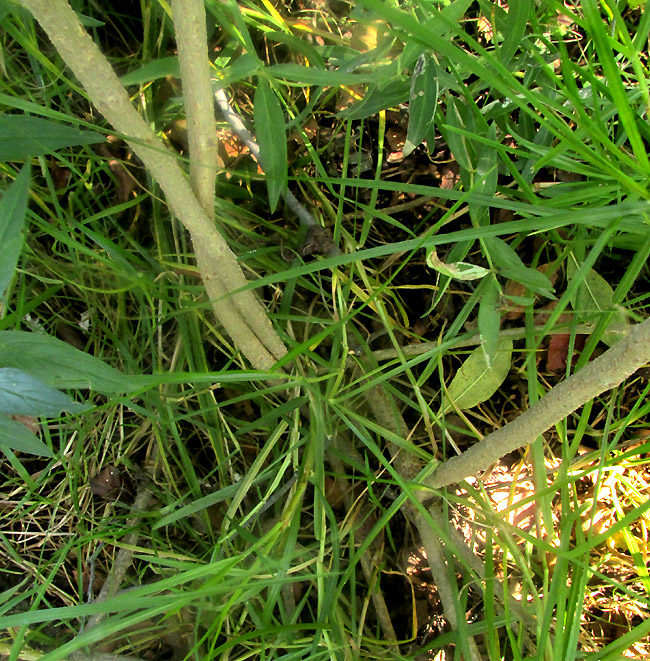Excerpts from Jim Conrad's
Naturalist Newsletter
Entry dated November 7, 2023, from notes taken at Cascadas de La Piedad waterfall 3kms NW of the community of San Pablo, municipality of Almeaco de Bonfil; bedrock of igneous andesite; N20.1008°, W100.0041°, elevation 2360 meters (7750ft); extreme southern Querétaro state, MÉXICO
SOLANUM ALIGERUM and/or SOLANUM PUBIGERUM

Even during the ongoing two-year dry period classified by the "North American Drought Monitor" as an extreme D3 drought, a small stream of clear, cold water meandered among livestock-grazed meadows and cornfields atop the valley's bed of pinkish, igneous andesite rock. Just before tumbling over a high ledge to create the picturesque Cascada de La Piedad, or Piety Waterfall, the above woody bush was thriving in a narrow band of bushes and trees along the stream. The dense clusters of shiny, black fruits among the branches are what caught my eye.

With such simple leaves on a woody bush, and dense panicles of fair-sized, spherical fruits atop long, stiff stalks, or peduncles, the first impression was that this must be one of many species of Solanum, in the Nightshade, Potato or Tomato Family, the Solanaceae. It was much like the Potatotree of that pedigree back in the Yucatan. A broken open fruit revealed seeds like those of a tomato, supporting that assessment:

Several details of the panicle's branches were noteworthy:


All the vegetative parts were short-hairy. The fruits' bottoms were cupped within calyxes with somewhat expanded, thin, papery lobes. Below the calyxes, the pedicels enlarged toward their tops and were flushed with purple. The pedicels' bases connected with the panicles' branches atop tiny stumps arising from the branches, better seen at the right. These stump-connections later proved valuable for identification the species.

On more mature panicles, fruits had been removed or fallen off, leaving strikingly white, star-shaped calyxes. Elsewhere on the same bush, younger flowers appeared to have recently lost their corollas, leaving only their maturing, green ovaries, each topped by a style and stigma:

The surprise there was that the calyxes and ovaries were so lopsided -- bilaterally symmetrical. At pedicle bases, note the grainy, white items, apparently aborted flower buds. Probably it had been too late in the season for large panicles to develop, but these few flowers on a late-maturing one possibly could.


Identification of the many, often very similar, Solanum species frequently relies heavily on features of hairs and spines. Some species are heavily spiny but most lack spines. Hairs can be simple or branched in various ways, long or short, crowded, disperse, or completely absent. Our plant's leaf undersurfaces were fairly densely short-hairy. The picture at the right shows many branched hairs, looking like tiny, white clumps, with simple hairs dispersed among them.

The bush was branched at its base; the bark gray and warty.
It can be hard to identify Solanum plants to species level, and that was the case with our streamside plant. Currently, the GBIF database recognizes 1,788 Solanum species occurring nearly worldwide. For our highland region of central Mexico, the 2010 digital edition entitled Flora fanerogámica del Valle de México, by Graciela and Jerzy Rzedowski, documents over 25 species.
Using that study, and particularly noting that our woody bush's leaves were not divided or lobed, that the plant wasn't spiny, calyx lobes were broadly and sometimes irregularly triangular, and that the leaves were generally short-hairy, our plant was identified as Solanum cervantesii. However, it got more complicated than that.
First, the authors noted that another similar species, Solanum aligerum, had been noted from the region, but that "apparently" our plants were not that. The "apparently" was noted, and wondered about. Second, the name Solanum cervantesii, according Kew's current Plants of the World Online database, has been designated as a synonym of Solanum pubigerum. Thus, so far in our understanding, our plant is Solanum pubigerum, but we're still wondering about Solanum aligerum. Both species occur in central Mexico.
To compare the two species, I made the following chart, using details mentioned in different publications:
| S. aligerum | S. pubigerum |
|---|---|
| fruits black or dark green | fruits red |
| stems winged with ridges | stems not winged |
| leaf undersurfaces with branched hairs concentrated in vein axils | leaf undersurfaces with simple hairs along the midveins and blade edges |
Our plant's fruits are black like those of S. aligerum, but our plant's stems are wingless, like S. pubigerum. The structure and distribution of hairs on our plant's leaf undersurfaces are unlike those described for either species.
In the 2013 study by Sandra Knapp entitled "A revision of the Dulcamaroid Clade of Solanum L. (Solanaceae)," it's recognized that "... Solanum aligerum is extremely similar to Solanum pubigerum, with which it broadly overlaps in central Mexico and Central America." However, it's said, there are differences in calyx lobe shape between the two species, but "this can be difficult to see." Also, the stems of S. aligerum are not always winged.
This vagueness about details used to distinguish the species, and the two species occupying much the same distribution area -- though the authorities are in conflict over South American populations -- my impression is that the two species most likely are intergrading forms of the same taxon. Moreover, here in central Mexico -- Mexico being the center of diversification of Solanum -- our plant is just one expression of that evolving complex.
However, technically, as it stands -- at least until someone does the genetic sequencing -- two species are recognized. And our plant most likely is both of them.